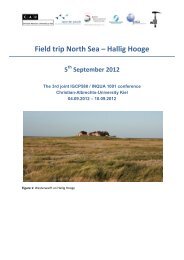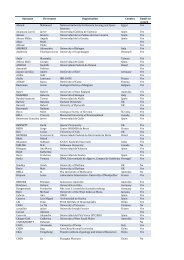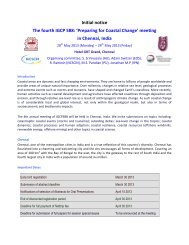Conference program and abstracts - Coastal-Change.Org
Conference program and abstracts - Coastal-Change.Org
Conference program and abstracts - Coastal-Change.Org
You also want an ePaper? Increase the reach of your titles
YUMPU automatically turns print PDFs into web optimized ePapers that Google loves.
<strong>Coastal</strong> wind climate, coastal dunes <strong>and</strong> ventifacts:<br />
mismatch or misinterpretation?<br />
Jasper Knight 1 , Helene Burningham 2<br />
1<br />
School of Geography, Archaeology <strong>and</strong> Environmental Studies, University<br />
of the Witwatersr<strong>and</strong>, Private Bag 3, Wits 2050, Johannesburg, South Africa<br />
(jasper.knight@wits.ac.za)<br />
2<br />
Department of Geography, UCL, Pearson Building, Gower Street, London,<br />
WC1E 6BT, UK (h.burningham@ucl.ac.uk)<br />
ABSTRACT<br />
The Atlantic-facing coast of western Irel<strong>and</strong> experiences a high-energy<br />
onshore wind climate controlled by seasonal patterns of cyclones <strong>and</strong><br />
variations in North Atlantic Oscillation index (Burningham <strong>and</strong> French,<br />
2013). Due to late Pleistocene glacial erosion the coast is also s<strong>and</strong>-rich,<br />
with well-developed coastal dune systems, s<strong>and</strong>y beaches with wide<br />
intertidal zones, <strong>and</strong> s<strong>and</strong>-filled estuaries. The combination of strong<br />
onshore winds, high sediment availability <strong>and</strong> sea-level readjustment<br />
throughout the Holocene has led to the formation of extensive coastal<br />
s<strong>and</strong> dunes (Carter, 1990) <strong>and</strong>ventifacts (Knight <strong>and</strong> Burningham, 2001;<br />
Knight, 2005). One problem in reconciling these diverse environmental<br />
variables, however, is the mismatch in spatial <strong>and</strong> temporal scales of<br />
observations. Geomorphological evidence for wind activity records the<br />
net effect of winds over long (10 2 -10 4 yr) time scales, whereas wind records<br />
themselves only span shorter time scales (10 -1 -10 2 yr) but are of higher<br />
resolution. In addition, radiocarbon-dated buried soils within s<strong>and</strong> dunes<br />
<strong>and</strong> macroscale s<strong>and</strong> dune morphologyare difficult to interpret within the<br />
context of periods of enhanced storminess, sediment fluxes between<br />
beach <strong>and</strong> dunes, <strong>and</strong> dune deposition <strong>and</strong> non-deposition (stability).<br />
Likewise, the millennial-scale record of human occupation of these dunes<br />
does not explain the subtle interconnections between dune surface<br />
disturbance, human activity, climate, <strong>and</strong> ecosystem changes (Knight<br />
<strong>and</strong> Burningham, 2011). In order to better examine therelationship<br />
between wind climate <strong>and</strong> its implications foraeolian sediment transport<br />
<strong>and</strong> the formation, development <strong>and</strong> maintenance of coastal dunes <strong>and</strong><br />
ventifacts, we use high-resolution coastal wind records over a 2-day<br />
period from a site in County Donegal, NW Irel<strong>and</strong>, where coastal dunes<br />
<strong>and</strong> ventifacts are actively forming at the present time. The results have<br />
implications for the relationships between climate forcing (as defined by<br />
st<strong>and</strong>ard measures of wind climate) <strong>and</strong> l<strong>and</strong>forms such as coastal s<strong>and</strong><br />
dunes <strong>and</strong> ventifacts that are often linked uncritically to short time-scale<br />
wind datasets. This is likely a significant source of mismatching <strong>and</strong>/or<br />
misunderst<strong>and</strong>ing in the climatic interpretation of such coastal l<strong>and</strong>forms.<br />
The Fourth IGCP 588: PREPARING FOR COASTAL CHANGE 17





